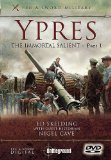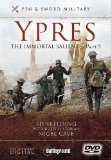 Ypres-The Immortal Salient Part 1 | DVD | (21/04/2011)
from £11.99
| Saving you £3.00 (25.02%)
| RRP
Ypres-The Immortal Salient Part 1 | DVD | (21/04/2011)
from £11.99
| Saving you £3.00 (25.02%)
| RRP This film is presented by historian and film-maker Ed Skelding who takes us on a chronological journey through the first two years of fighting in the salient. He is joined by renowned military historian and author Nigel Cave who will join Ed at some key locations where decisive actions took place. Nigel is well known for his contributions to the Battleground Europe series of guide books published by Pen & Sword. This film will feature locations associated with the first two battles of Ypres, including Hooge Chateau, Langemark and Gheluvelt where the first encounters between the opposing armies took place. The story of the 1914 Christmas truce will be explained by Nigel and the nearby locations where the artist Bruce Bairnsfather drew the cartoons that were to establish the character of Old Bill. Nigel is also interviewed at the notorious location of Hill 60, where he reads from his Battleground Europe book, and explains why this was such a dreaded place, even for the Salient. The second part of this film then switches to the Second Battle of Ypres in April 1915. This became notorious for the first real gas attack of the war and was to change the attitude of the British soldiers towards the Germans. Gone forever was any notion of chivalry. Nigel is interviewed at Vancouver Corner - where an impressive memorial to the Canadians who died defending the line despite suffering many casualties from the gas – now stands. He also takes us to the nearby Totemuhle or Death Windmill to explain where the gas attack came from and the resulting lost opportunity for the Germans. This film will also tell the story of the Royal Army Medical Corps and the doctors who did so much often in the most desperate circumstances. Nigel is interviewed at Essex Farm, forever to be associated and immortalized by the poem of the Canadian Colonel John McCrae – In Flanders Fields.
 Ypres - The Immortal Salient Part 2 DVD | DVD | (30/06/2012)
from £18.88
| Saving you £-1.89 (-11.10%)
| RRP
Ypres - The Immortal Salient Part 2 DVD | DVD | (30/06/2012)
from £18.88
| Saving you £-1.89 (-11.10%)
| RRP Presenter Ed Skelding is joined once again by military historian and author Nigel Cave to take us through the complexities of the final stages of the fighting for the Ypres Salient. This film starts with the story of the successful attack on Messines and the taking of the ridge and the village. This includes interviews with Nigel at Factory Farm and Spanbroekmolen where two of the nineteen mines were detonated to herald the start the attack early on the morning of the 7th. Nigel will also explain how four of the mines were left undetonated when the line of attack was changed. One of those mines suddenly exploded as the result of a thunderstorm in 1956 while no one is quite sure where the other three are! We also visit Prowse Point and Lone Tree Cemeteries with Nigel where he explains the nature of the different types of cemetery – battlefield, collection etc. This film will also feature an interview with Annelies Vermeulen, Chief Executive at Talbot House in Poperinge. She explains what a source of refuge and comfort the place was for soldiers looking for respite from the fighting. While in Poperinge, we also visit the jail and execution post behind the Town Hall where several British soldiers were executed or – shot at dawn. We also explain the thinking behind this, with a possible interview with the late Earl Haig. In this film the team visit the Ploegsteert memorial to Churchill with Nigel and later visit the trenches once used by Adolf Hitler at Croenaert Wood. Ed then starts his presentation of the Battle for Passendaele and related how it was actually a succession of battles fought from 31st July to mid November. As part of this explanation, Ed is joined by Nigel at ANZAC memorials in Polygon Wood where he explains the bitter nature of the relentless fighting. This film is completed by an extended and powerful interview with Nigel held on top of the Cross of Sacrifice memorial at Tyne Cot, when Nigel explains the power behind The Immortal Salient.
![Cry Of The Innocent [1980]](/pictures/1053410.jpg) Cry Of The Innocent | DVD | (21/06/2004)
from £10.20
| Saving you £-6.21 (N/A%)
| RRP
Cry Of The Innocent | DVD | (21/06/2004)
from £10.20
| Saving you £-6.21 (N/A%)
| RRP 
Please wait. Loading...
This site uses cookies.
More details in our privacy policy